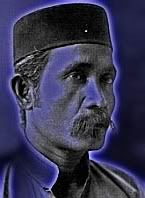A Sword in the Stone
From the bend at the house of the Isaacs, whose pater familias founded the Grammar School, to the intersection of Tanjong, was a short, long road with many tales.
Kolam or Kolang as we knew it in the vernacular, is a body of water, but there was no pond (“kolam”) in the area as we knew it. It had gravestones, laid out over a vast stretch just yards from the road as it bent, and the old cemetery stretched all the way to the Sekolah Paya Bunga. This curve on the edge of this old cemetery was perhaps Kolam proper, where the road took an almost ninety degree turn to avoid the Istana, the late lamented residence of Sultan Sulaiman Badrul Alam Shah and the birthplace of the Trengganu gamelan and the joget gamelan Trengganu.
Walking away from this bend, going towards the visible minaret of Masjid Abidin, was probably the expanse of Kampung Patani, whose name may hold the key to the old cemetery of unknown people. This was perhaps the resting place of travellers from the place that gave the name to this village – when it was a village – and they were probably the henchman and women and the courtiers and the maids in train who came down with the would-be sultan Zainal Abidin the first, a Johorian, who answered the call of Trengganu when he was in the southern kingdom as the adopted son of its ruler, Phra Nang Chau Yang. Johor and Patani had interesting links in history as may be gleaned from the Syaer Dang Sirat.
But I am taking you now, some three hundred years later, to the magnificent tamarind tree in the bend near the istana, to look down the straight path of the Jalan Kolam towards the sea. I knew the tree very well as I used to walk in its shade most days, and there were goldsmiths' shops across the road, and a hair dresser, and the house of Cikgu Wè, brother of the young Döllöh who beat the geduk at the masjid; and there was the house of Mr Isaacs, of course, with his Jaguar in the car port, and in the night when the lights went dim, unseen hands rustled leaves and spirits and ghouls dangled with the boomerang fruits of the tree.
And I look forward now, to the house of Pök Lèh Kastang, a genial old man already long retired from his daily work in the Customs office when I used to see him bathe at the well right by his house as I sat in the trishaw of Pök Mat after he'd dropped my classmate Tay Huay Cheng in Kampung Aur after our afternoon school.
But no, says my friend Ajidul. Look right as you walk away from the tamarind tree (in the bright light of day, of course) and you'll see a strange old grave marked by a sword that also served as the Christian cross, on the edge of what was another old Muslim cemetery. And he has sent me a graphic representation of this mysterious place of repose to bring back a bit of old memory:
 I am afraid I cannot recall having seen such a place. If I did I would have stopped to look at the sword that was also a cross as it would indeed have been a major object of curiosity in this corner of Kolam/Kampung Patani.
I am afraid I cannot recall having seen such a place. If I did I would have stopped to look at the sword that was also a cross as it would indeed have been a major object of curiosity in this corner of Kolam/Kampung Patani. It is no longer there, Ajidul now says. It was pulled down long ago. And as is typical of Trengganu demolition works, no one thought to keep the sword in the stone as a record that some foreign soul was once interred there in the earth of Trengganu. But who? And why was s/he there at all?
Perhaps someone out there will remember, I told Ajidul. Perhaps someone will come and tell us that s/he too saw the sword in the stone just yards from the tamarind tree. And to help jog other memories, my friend Ajidul has sketched a map here to show the house of Pök Lèh, and the cemetery and the haunted tree:

Labels: Ajidul, Cikgu Wè, Döllöh, Isaacs, Istana Kolam, Joget Nobat Trengganu, Kampong Kolang, Nobat Trengganu, Pök Lèh Kastang, Tay Huay Cheng

